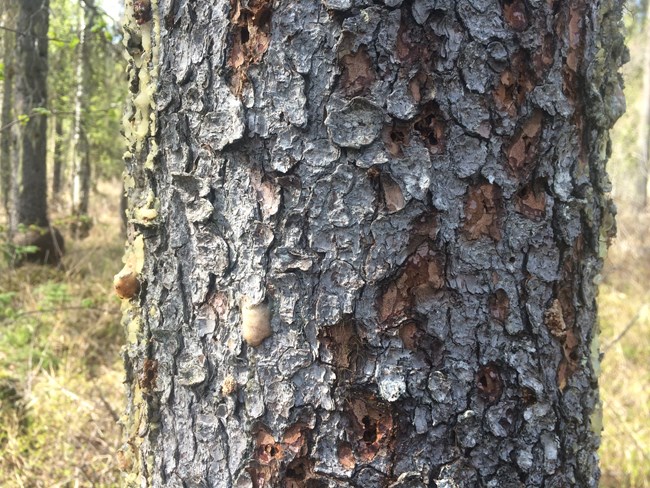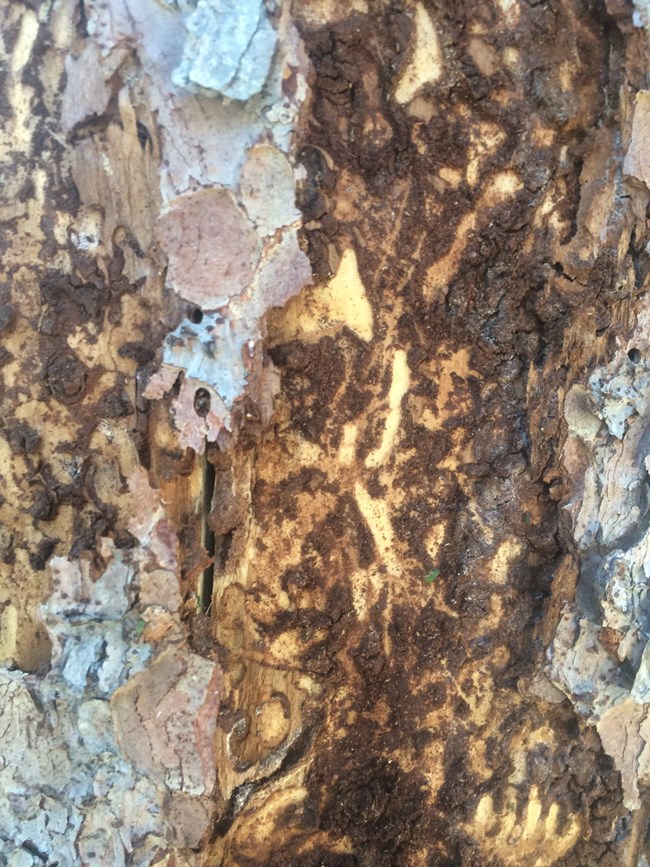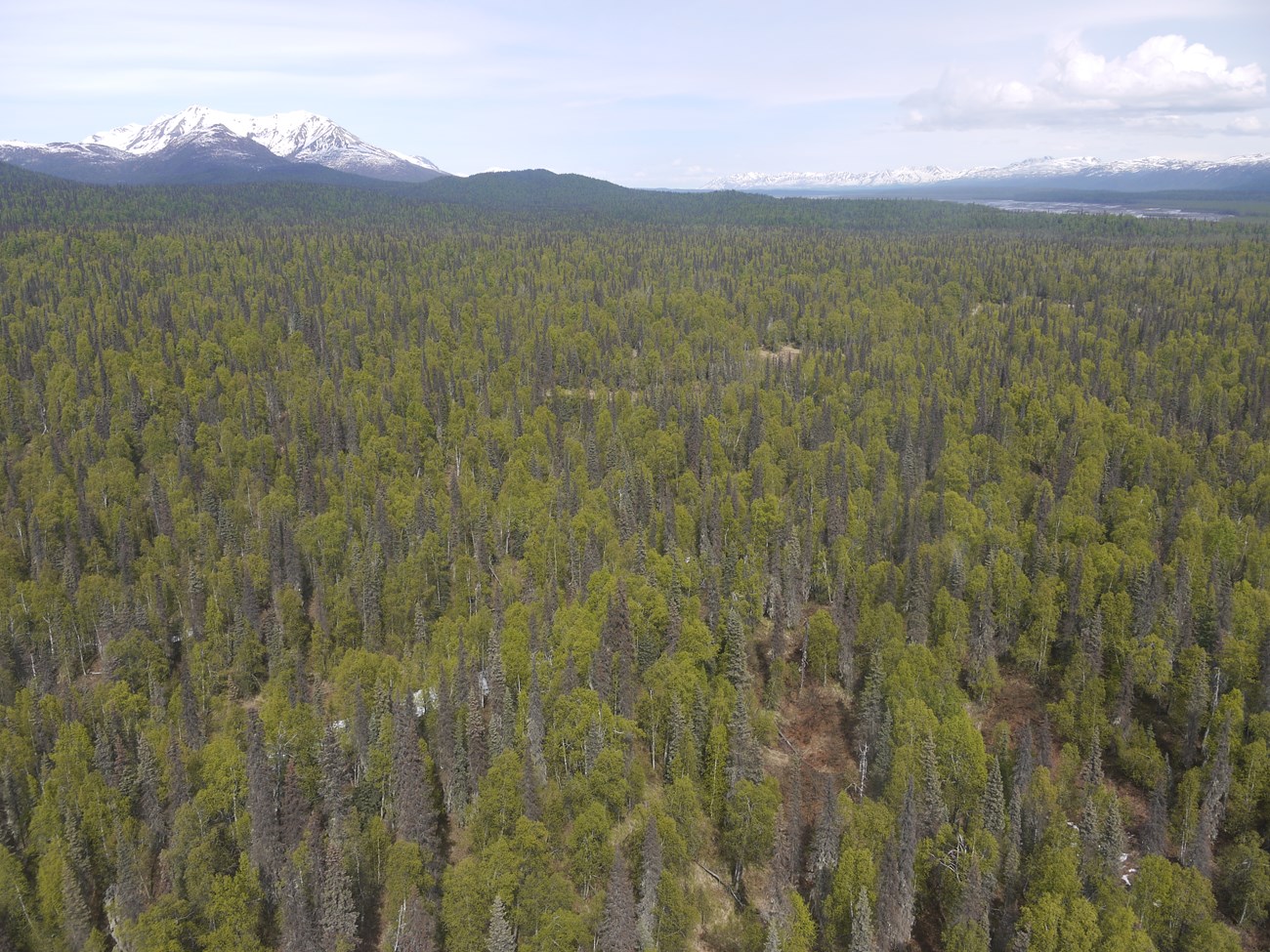Last updated: May 23, 2025
Article
Assessing the Risk of Denali's Forests to Spruce Beetle Outbreak
Spruce Beetles are Home in Alaska’s Forests
Spruce beetles (Dendroctonus rufipennis) are a type of bark beetle—they bore through a tree’s bark to feed in its sugary phloem tissue. Phloem is the innermost layer of the bark and serves to transport compounds produced via photosynthesis to other parts of the tree. Severe disruption in phloem tissue, such as through a high number of beetles feeding, starves the tree and can cause tree death. Spruce beetles also bring a blue-stain fungus that plugs up the water-transporting tissue in the tree, speeding up tree death.
As a natural part of Alaska’s forest ecosystems, the native spruce beetles have a history of instigating large spruce die-off events in many regions of the state. Their primary hosts are white, Lutz, Sitka, and sometimes black spruce. In the 1990s, Alaska’s Kenai Peninsula and Copper River valley experienced a spruce beetle outbreak that had affected nearly 2.3 million acres by its peak in 1996 killing most large diameter spruce trees in many parts of those regions (Werner et al. 2006). Beginning in 2016, it was southcentral Alaska’s turn again. A 2016 aerial detection survey mapped 190,000 acres of spruce beetle damage—a nearly sixfold increase over the amount of damage detected in 2015—signifying the start of another beetle outbreak (Dubois and Wurtz 2016).
These forests of suddenly dead and dying spruce are different than forests of live trees. The effects are highly visible when travelling along the Parks Highway between Wasilla, Talkeetna, Denali State Park and Cantwell. As needles fall from the canopy, more sunlight and rain reach the forest floor. Dead trees provide ample fuel in the event of wildfire. Recreational opportunities are affected, as some campgrounds close temporarily due to risk of falling trees.


Left image
Credit: NPS Photo
Right image
Credit: NPS Photo

NPS Photo / Sarah Stehn
Spruce Beetles are Home in Denali
Spruce beetles are native to the spruce forests across Alaska. The recent outbreak of spruce beetles in southcentral Alaska has drawn attention to the damage they can cause when found in high numbers. At the northern edge of that infestation, spruce beetle damage has been observed in the southern portions of Denali National Park and Preserve and in forested lands along the Parks and Denali Highways (Dubois and Charnon 2019).Recognizing infestation
In spruce beetle-infested trees, you may find small, 1/8th-inch diameter holes in the trunk, especially the lower portion. Often, these holes are accompanied by piles of ‘sawdust’-like wood material at the tree base. Adult spruce beetles bored these holes, which are sometimes covered with thick, opaque resin called pitch tubes—the tree’s defense against attack (Figure 1). Healthy spruce may defend against a spruce beetle attack by pitching out the beetle, trapping it in resin before it can lay eggs within the tree. Older or stressed trees are less successful at pitching out attacking spruce beetles. Besides holes and pitch tubes, needles of infested spruce trees change color from green to yellow, orange, or red before they fall off. In the first season of attack, however, the needles remain green, with the needle color change occurring in the second season after infestation, and the tree often dies. Recently infested trees serve as a source population for further host tree attacks.The beetle’s life cycle
Adult spruce beetles become active and disperse to attack new trees when temperatures reach 60° F (15.6° C), around the end of May through June. After boring into a suitable spruce tree (usually by July) and mating, a female spruce beetle lays her eggs within the bark. The eggs soon hatch into larvae which feed, grow, and pupate within the phloem of that spruce tree, beginning to disrupt the flow of nutrition for the tree (Figure 2). Under typical conditions in southcentral Alaska, spruce beetle have a two-year life cycle, spending their first winter as larvae, then transforming into pupae and adults before overwintering again and emerging the following spring. In Interior Alaska, spruce beetle typically have a one-year life cycle, developing from egg to adult within one season before overwintering and emerging the following spring. In both cases, some subset of the adult beetle population may preferentially overwinter near the base of spruce trees where snow cover can insulate them from severe cold. Older trees are the most suitable to overwinter within, as their thick bark aids in protecting the beetles.It is these relationships of the beetles’ life stages to air temperature that are thought to partly control beetle populations (Bentz et al. 2010). For instance, during a particularly warm spring, beetles may become active earlier in the season. Warm temperatures can also alter their life cycle timing. Conversely, a severe winter may kill beetles overwintering above the snowline. Further, trees already weakened by drought stress may be more susceptible to damage.
The current outbreak of spruce beetles in southcentral Alaska has already affected portions of Denali National Park and Preserve, and many of the spruce found south of the high mountains of the Alaska Range have died (Figure 3). As the outbreak marches northward, it is possible that the Alaska Ranges' influence on weather and climate patterns may act as a barrier to severe outbreak in the forested lands near the Denali Park entrance. Interior Alaska's cold winters or shorter summers may keep beetle populations from reaching the outbreak populations observed in the more southerly climates of southcentral Alaska. However, with evidence of the climate trending warmer, staff continue to monitor for beetle activity, in anticipation of potential dramatic changes to Denali’s forest structure and visitor experience.

NPS Photo / Sarah Stehn
What Would an Outbreak Look Like?
Spruce beetles are a native insect and their dispersal and even outbreaks are natural processes. They already call Denali home, but a few variables will affect whether their populations reach outbreak levels. For instance, researchers have linked the severity of past outbreaks to a series of warmer and drier than normal summers (Werner et al. 2006). Observed climatic warming is thought to increase the number of beetles that complete their life cycle in one year instead of two (Bentz et al. 2010). And trees that are drought stressed have a harder time defending from attack. Additionally, random events such as large-scale windstorms that produce many fallen trees can provide ample food for local spruce beetle populations, creating host sites for larger-scale outbreaks.When considering the potential for spruce beetle populations to grow in Denali, one can envision different outcomes for Denali’s spruce over time. As climate and other factors keep in check or release the population of spruce beetles, the size and duration of their infestation will be determined.
In a minimal effects’ scenario, Denali’s mixed-species forests, formed as a mosaic of beetle-preferred host species (i.e., white spruce) and non-preferred host species will limit the spread of spruce beetles. Healthy spruce stands will pitch out many of the attacking beetles, and a good dose of Interior Alaskan winter cold will limit populations. Spruce death will still occur and may be dramatic for human and animal inhabitants of those local areas.
In a greater effect scenario, spruce beetles will infest patches of white spruce monoculture in Denali. Then, perhaps boosted by a widespread and damaging wind event, beetles will attack and kill additional large tracts of trees. A series of warm and dry summers, coupled with mild winters may mimic conditions of climates further south, allowing beetles to complete their life cycle faster, or survive at a greater rate through winter. A prevalence of drought-stressed trees may be unable to defend against beetle attack, leading to high spruce death throughout the region. The increased fuel load would increase the risk and severity of wildfires. Animals living in affected areas may have to find new habitat and food sources. Deciduous trees, frequent after disturbance, may enjoy dominance in places where mature spruce once grew.
Between these scenarios, and perhaps the most likely, a moderate level of spruce beetle infestation may kill local populations of spruce in Denali. Human use of beetle-killed areas may change, at least temporarily, as standing dead trees become a fall hazard. A change in understory plant cover may occur in newly opened spaces, but regional forest composition will remain relatively unchanged. Small spruce that either survive attack or are too small to be susceptible will remain and gain dominance. Depending on the extent of spruce beetle-caused tree mortality, an increased fire risk may be of concern. A particularly cold winter, or a series of late springs, may keep the length or magnitude of the outbreak relatively short.

NPS Photo / Davyd Betchkal
2025 Update
Widespread death of White Spruce (Picea glauca) due to spruce beetle infestation has occurred throughout much of southern Denali National Park and Preserve, and now is visible throughout several forested drainages on the northern slope of the Alaska Range, including that of the Yanert Fork River, Healy Creek, Riley Creek, Upper Savage and Upper Sanctuary Rivers. Large patches and swaths of dead spruce trees are notable along the Parks Highway, including in and around the park-adjacent communities of Cantwell, Carlo Creek, McKinley Village, and even north towards Healy.
Notable Spruce Mortality
The U.S. Forest Service’s Forest Health Protection Program, in collaboration with the Alaska Department of Natural Resources, Division of Forestry, maps forest health conditions throughout the state annually. Flight and ground operations in 2024 confirmed that although many areas have seen a precipitous drop in spruce beetle activity, outbreak level activity continues to occur in and around Denali.
During summer 2024, informal surveys along trails in the park entrance area (at mile 231 and 237 of the Parks Highway) revealed frequent sign of spruce beetle activity, with some forest stands heavily infested and spruce mortality common. Although groups of dead or damaged trees are apparent, they remain interspersed with healthy forest.
Continued Research
Since 2021, personnel from the Alaska Department of Natural Resources, Division of Forestry have placed Lindgren funnel traps, a standard tool for bark beetle monitoring, near the Park entrance area. In coordination with Park staff, traps were monitored bi-weekly throughout the summer months to provide information on spruce beetle flight timing, duration, and relative population numbers.
Despite the signs of spruce beetle activity and tree mortality seen across the area, the numbers of beetles collected via monitoring traps in 2021, 2022, 2023, and 2024 were consistent with low or endemic population levels at those locations. Monitoring will again occur in summer 2025.
Forest Outlook
Time will tell how long southcentral Alaska’s current spruce beetle outbreak will last, how far it will spread, and how many spruce are infested and die. The continuation of this outbreak into interior Alaska, where large outbreaks have been more rarely observed, is of interest. Several research projects are underway in and around the Denali area to detect spruce beetle infestation, monitor ecological change related to beetle-related mortality, and identify management actions that may be needed to ensure protection of infrastructure and visitor safety.
Disturbance to Denali's forest, even if severe, opens opportunities for other natural ecological processes to occur. Keeping an eye out for disturbances as they develop, such as spruce beetle outbreaks, is important to understanding Denali’s forest habitats.
Acknowledgements
We thank Jason Moan and Martin Schoofs of the Alaska Dept. of Forestry for their review of and insightful contributions to this article.
References
Bentz, B. J., Régnière, J., Fettig, C. J., Hansen, E. M., Hayes, J. L., Hicke, J. A., Kelsey, R. G., Negrón, J. F. and S. J. Seybold. 2010. Climate change and bark beetles of the Western United States and Canada: Direct and indirect effects. Bioscience 60: 602-613.
Brannoch, S. and J. Moan (eds.). 2020. Forest Health Conditions in Alaska 2020. Anchorage, Alaska. U.S. Department of Agriculture, Forest Service, Alaska Region. FS-R10-FHP. Publication R10-PR-46. 76 pp.
Dubois, G. and B. Charnon (eds.). 2019. Forest Health Conditions in Alaska 2019. Anchorage, Alaska. U.S. Department of Agriculture, Forest Service, Alaska Region. FS-R10-FHP. Publication R10--PR-45. 68 pp.
Dubois, G and T. Wurtz (eds.). 2016. Forest Health Conditions in Alaska 2016. Anchorage, Alaska. U.S. Department of Agriculture, Forest Service, Alaska Region. FS-R10-FHP. Publication R10-PR-39. 74 pp.
USDA-FS Forest Health Protection. 2021. Alaska Forest Health Highlights Story Map. Available from: https://storymaps.arcgis.com/stories/ed997a1559ba4a3083c980e0dd2ad626. Accessed April 11, 2022.
Werner, R. A., Holsten, E. H., Matsuoka, S. M. and R. E. Burnside. 2006. Spruce beetles and forest ecosystems in south-central Alaska: A review of 30 years of research. Forest Ecology and Management 227: 195-206.
